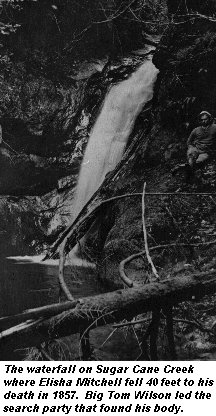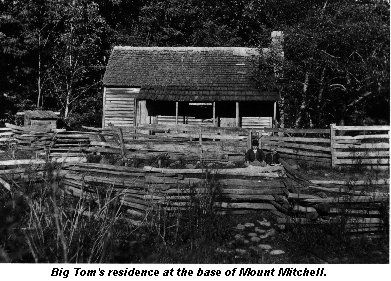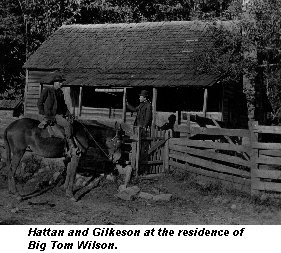
On a long ago mountain holiday our party retraced the
historic steps of Dr. Elisha Mitchell and Big Tom Wilson.
By Mary Hattan Bogart
There was an epic written in Babylon about B.C. 2000 concerning a king named Gilgamesh and a wild man named Enkidu who became great friends. They go to a great mountain to cut trees, but before they can cut the trees, they must fight the god of the mountain, Humbaba. Gilgamesh goes in front of Enkidu, who has a healthy fear of the mountain, having lived on the mountain. The king decides if they conquer Humbaba, they will put a monument atop the mountain which will intitle them to immortality.
In A.D. 1834, there was a modern Gilgamesh, named Elisha Mitchell,
who with his mountain friend, Big Tom Wilson,
climbed to the top of the Black Dome in the Black mountains of North Carolina.
He went there not to cut trees, but to measure the height
of what he believed to be the highest mountain in the Eastern United States.
There arose a controversy between Mitchell and a man named Thomas Clingman,
who claimed that the highest one was another close by.

Urged on by the determination to settle once and for all the false claims of Senator Clingman, Dr. Elisha Mitchell set out on June 27th, 1857 to prove to the world that he was the first to measure the Black dome. Leaving his son who accompanied him, at the Half-Way House, a lodge built as a summer home by William Patton of Charleston, S.C., he continued on alone planning to meet his guide, Big Tom Wilson, who lived in a mountain cabin on the other side of the mountain. Failing to return by the following week, a search party was formed and headed by Big Tom to scour the rough and almost impassable mountain. Finally, after two days search by hundreds of men, Dr. Mitchell's body was found by Big Tom at the bottom of a 40 ft. ledge, immersed in an icy pool beneath a mountain waterfall.
The body was painfully and laboriously brought down from its watery grave and buried in Asheville, but a year later, his remains were carried to the top of the mountain and laid in a shallow grave covered by rocks where all who knew him felt he deserved to be.
The loss of Dr. Mitchell's life was a blow to the scientific community of North Carolina and to the University where he taught in Chapel Hill. Trained as a minister and educated at Yale, he later joined the faculty of the University of North Carolina as a professor of Mathematics.

The story is well documented and Dr. Mitchell proved with his life that his measurement of the Dome was moe accurate than Senator Clingman's. There were many differences in the measurement through the years, but it is now established by Geological Survey to be 6684 ft. to the top. Mitchell made five trips checking and rechecking his measurements, finally revising them to 6672 - only 12 ft. off the present Almanac figure.
Since that fated day, Big Tom Wilson became a legend to all who heard the story. The colorful mountaineer lived in a typical crudely built mountain house 7 1/2 miles beneath the peak of the Dome where he spent most of his time bear-hunting, watching for game poachers and acting as guide to curious travelers ambitious enough to climb the mountain where the tragedy took place. He loved to talk, telling the story over and over, never tiring of its repetition. But most of all he liked to tell stories of how he tracked bears through the forest.
 Many were the curious who beat a track to his door at the foot of the mountain;
some to hear his story; some to retrace themselves the long trek to the top.
Such was the intent of a party of engineers who were working on the spiral
"Loops" of the Clinchfield Railroad near Altapass, some 50 years later.
Many were the curious who beat a track to his door at the foot of the mountain;
some to hear his story; some to retrace themselves the long trek to the top.
Such was the intent of a party of engineers who were working on the spiral
"Loops" of the Clinchfield Railroad near Altapass, some 50 years later.
On an "engineer's holiday", a party of four, Hattan, Deacon, Morrison and Gilkeson, set out to climb the mountain on a bright autumn day in October, 1907. The weather was ideal and predicted to hold for the next few days. On the morning of the 6th, following the east prong of the Caney River, the party reached Big Tom's residence. Upon arriving at the house, clearly marked by a sign over the front porch, it seemed deserted. Deacon and Morrison stayed at the house while Hattan and Gilkeson went in search of information. Finding Dick Wilson, Big Tom's son, they persuaded him to act as their guide and rented two pack mules to carry their gear.

Returning to the house, the four engineers waited while Dick went in search of his father who was visiting a neighbor. Big tom, as usual, was always glad to retell his story - even agreeing to sit for his picture with his wife and grandchild.
Big Tom, now 87, no longer acted as guide for the strenuous mountain climb, but his six foot two frame still showed the strength of long years of warfare with the bears. His short cropped beard framed his face under a black, wide brimmed, stovepipe hat, pulled down until it almost covered his tranquil blue eyes. His still almost unlined face belied his advanced age and although he walked with a handmade cane, it was more for prevention or protection than need. He was a mild man, simple and unassuming - proud that no one knew the mountain as he did. Skinning bears seemed to be his greatest pleasure - telling about them the next best.
After a short visit the party was ready to start the long climb. The path up the mountain was well traveled, winding through and around thick growths of rhododendron and mountain laurel, following the creek back and forth across rocks and brush many times. Sometimes the rocky path was perpendicular and treacherous to the mules as they clambered over the wet and slippery rocks. Before they reached the thick balsam growth,
 Dick Wilson pointed out the largest tree in the Alleghanies - a tulip poplar,
appropriately called the "Big Tom."
The circumference of the tree was 396 inches and it stood 60 or more feet
before putting out the first limb.
Dick Wilson pointed out the largest tree in the Alleghanies - a tulip poplar,
appropriately called the "Big Tom."
The circumference of the tree was 396 inches and it stood 60 or more feet
before putting out the first limb.
 The party laboriously wended its way over creek beds and thick underbrush
until they came to a mass of ragged projections covered with deadened tree
trunks, where the vegitation changed to thick balsam growth,
tall grasses and slippery rock ledges.
At the top was a crag about 200 ft. high where the stunted growth
was peppered occasionally with the heavy balsams,
but the dead trunks of trees stood out like tall gravestones
in a forest which had tried desperately to grow in the rocky soil.
The party laboriously wended its way over creek beds and thick underbrush
until they came to a mass of ragged projections covered with deadened tree
trunks, where the vegitation changed to thick balsam growth,
tall grasses and slippery rock ledges.
At the top was a crag about 200 ft. high where the stunted growth
was peppered occasionally with the heavy balsams,
but the dead trunks of trees stood out like tall gravestones
in a forest which had tried desperately to grow in the rocky soil.

Late that afternoon, a tired but exhilarated party reached the summit where they found the Professor's grave surrounded by a ledge of rocks, laid there in loving tribute by each visitor who came to this lonely place. Above it stood a monument 12 ft. high with the following inscription:
|
Resurrection the body of the Rev. Elisha Mitchell D.D. Of the University of North Carolina Lost his life in the scientific exploration of this mountain in the 64th year of his age. June 27th, 1857. Erected in 1888. |
The Black Dome was renamed Mt. Mitchell and from the summit of this magnificant dome, the whole world seemed to stretch out below in an endless chain of peaks and ridges bathed in ribbons of muted color in the late evening sun. In the crevices where one mountain's shadow fell across the other, were great splotches of dark blue, standing out in contrast to the fleecy white of an occasional cloud pierced by a craggy peak. Towards the south the Great Smokies loomed through the familiar haze that named them. Towards the northeast stretched the long range of the Alleghanies, Table Rock, Hawk's Bill and beyond that, Grandfather Mountain.

After a chilly night spent in their not too warm bedrolls, the men started back down the east prong of the Caney River to Big Tom's residence. Dick Wilson led them down the path where Mitchell's body was discovered after a 40 ft. drop from the rocks above the falls on Sugar Cane Creek into a pool about 15 ft. deep. The descent was much more treacherous than the ascent and it was easy to see how a man could meet with disaster when the malevolent darkness of the night closed in on him.
Dr. Elisha Mitchell fell to his death as did Gilgamesh in the ancient epic, but the monument stands above the mountain named in his honor as a claim to his immortality.
'Who, my friend, can scale heaven?
Only the gods live forever under the sun.
Whatever they achieve is but the wind'...
Let me go then before you,
Let your mouth call to me, "Advance, fear not,"
Should I fall, I shall have made me a name;...
Gilgamesh - They will say - against fierce Humbaba Has fallen!"
- The Epic of Gilgamesh, B.C. 2000
